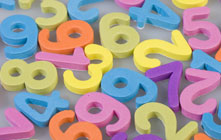Easy Math Problems for Beginners
If your child isn't confident in his math skills, one way to build confidence is to provide easy math problems for him to practice at home. This can help him prove to himself that he can succeed, which may make him more willing to tackle harder problems. Read on for tips on how to formulate sample problems.

How Do I Create Easy Math Problems?
Achieving success when learning a math new topic can help build your child's determination and stamina, in addition to increasing his or her motivation to continue learning. If you're formulating easy math problems for your child to complete at home, make sure they are straightforward and able to be solved with basic knowledge. Avoid trick problems, and try to stick to just one operation at a time. You might use the sample problems below as a guide.
Sample Problems by Topic
Arithmetic
1. 3 + 5
- In arithmetic, easy math problems would involve addition or subtraction (without any carrying or borrowing). When creating your own problems, you might consider numbers that would be easy to add or subtract using counters, like fingers or small toys. The answer to this problem is 8.
2. Maggie ate five pieces of pizza, and Rick ate two. How many more slices did Maggie eat?
- It's a good idea to include easy word problems among your practice problems because many kids struggle with them. For this problem, your child should subtract 5 - 2. Maggie ate three more slices of pizza than Rick did.
Geometry
Geometry includes many formulas, including those used to calculate perimeter and area. In general, these problems are simple because students just have to plug in numbers to solve them; however, your child must knows which formula to use. For a rectangle, the formula for area is area (a) = length (l) x width (w). To calculate the perimeter of a rectangle, your child should add together the lengths and widths of the sides.
1. A rectangle is 2 inches long and 3 inches wide. What is its area?
- The rectangle's area is six square inches because 2 x 3 = 6. Make sure your child labels his or her answer with the correct unit of measure.
2. Mr. Talbot's yard is 14 feet long and eight feet wide. To fence it in, how much fencing would he need to buy?
- To calculate the perimeter of Mr. Talbot's yard, your child could add 14 + 14 + 8 + 8, or he or she could multiply each side by two: 2(14) + 2(8). The answer is 44 feet.
Other Articles You May Be Interested In
-
Creating Your Own Math Problems and Worksheets

Supplementing your child's math lessons with a few problems and worksheets of your own will help you become better acquainted with his or her curriculum, and will help your child perform better in the classroom. Here are some tips for creating them.
-
Sample Math Worksheet - Simple Addition

This simple addition worksheet is only a sample to help you format your own practice math problems. Includes answers.
We Found 7 Tutors You Might Be Interested In
Huntington Learning

- What Huntington Learning offers:
- Online and in-center tutoring
- One on one tutoring
- Every Huntington tutor is certified and trained extensively on the most effective teaching methods
K12

- What K12 offers:
- Online tutoring
- Has a strong and effective partnership with public and private schools
- AdvancED-accredited corporation meeting the highest standards of educational management
Kaplan Kids

- What Kaplan Kids offers:
- Online tutoring
- Customized learning plans
- Real-Time Progress Reports track your child's progress
Kumon

- What Kumon offers:
- In-center tutoring
- Individualized programs for your child
- Helps your child develop the skills and study habits needed to improve their academic performance
Sylvan Learning

- What Sylvan Learning offers:
- Online and in-center tutoring
- Sylvan tutors are certified teachers who provide personalized instruction
- Regular assessment and progress reports
Tutor Doctor

- What Tutor Doctor offers:
- In-Home tutoring
- One on one attention by the tutor
- Develops personlized programs by working with your child's existing homework
TutorVista

- What TutorVista offers:
- Online tutoring
- Student works one-on-one with a professional tutor
- Using the virtual whiteboard workspace to share problems, solutions and explanations